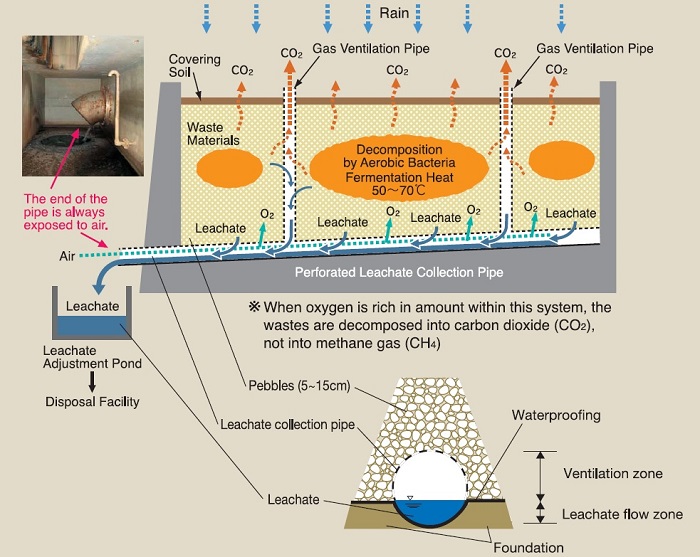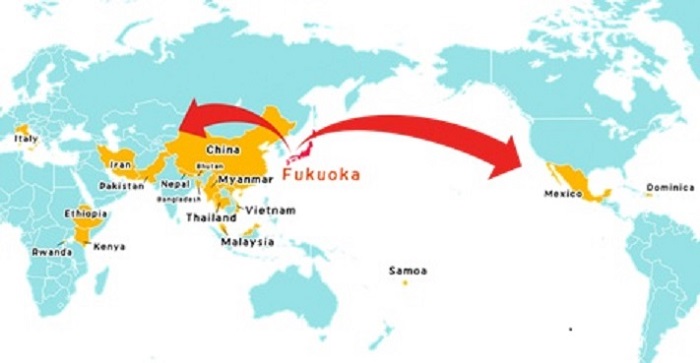Fukuoka Method(semi-aerobic landfill structure)draws worldwide attention.
1 Outline
The Fukuoka Method (semi-aerobic landfill structure) is an innovative technology for final disposal site originally suggested by Dr. Masataka Hanashima, a current professor emeritus of Fukuoka University, and put into practical application in cooperation with Fukuoka City and Fukuoka University.
In 1979, it was adopted as the standard landfill structure to be used in landfill sites in the Administrative Guideline for Final Disposal Sites established by former Ministry of Health and Welfare (currently Ministry of the Environment).
Since then semi-aerobic landfill structure is called as “the Fukuoka Method”. Fukuoka city, in collaboration with Fukuoka University, has been receiving oversea trainees and sending Japanese experts on this system to Asia Pacific and other regions in the world.
2 Semi-aerobic landfill Mechanism
The semi-aerobic landfill is a construction with the pebbles and the leachate collection pipes that are laid at the bottom of the landfill to drain away leachate as quickly as possible, preventing it from accumulating in the landfill layer. In this landfill structure, the leachate is discharged through horizontal collection pipes to the adjustment pond and does not infiltrate under the landfill and not contaminate the groundwater.
Also, the temperature rise generated by the microbial activity in landfill increases the difference between internal and external temperature, so the heat convection, which occurs in the leachate collection pipe (in the reverse direction of water flow), provides naturally more oxygen into the landfill. The oxygen helps to decompose waste materials by aerobic bacteria and decreases methane in the decomposition process. Therefore, the special air blasting facility is not necessary, and it makes easier the construction, operation and maintenance.
In this system the semi-aerobic landfill utilizes its characteristic features to accelerate the decomposition of waste materials and drain away the leachate inside the landfill.

3 Advantges of the Fukuoka Method
(A) The Fukuoka method utilizes the self-purifying capacity inherent in nature, that is decomposition by bacteria, to stabilize waste materials. The landfill method requires only commonly used machinery and equipment.
(B)The quality of leachate is improved significantly by accelerating decomposition of the waste materials.
(C) It reduces methane gas, and contributes to the prevention of global warming.
(D) Enhanced stabilization makes it possible to utilize the completed landfill earlier. Appropriate review of the usage and monitoring will be needed during that period.
(E) The Fukuoka Method is cost-effective and simple in the technology, and allows a high degree of freedom of material choices.
(F) It is easy to construct, operate and maintain. However, for the effective use of the Fukuoka Method, it is very important to understand its mechanism, management and maintenance of the landfill, and continue constant monitoring for the quality of leachate.
4 International Technical Cooperation
As for the technology transfer of waste material landfill technology to Asia-Pacific cities, Fukuoka City has been actively promoting the transfer of this technology in collaboration with Japan International Cooperation Agency (JICA) and United Nations Human Settlements Programme (UN-Habitat), and has been earnestly cooperating in reducing environmental pollution and methane gas, which result from local final disposal sites in the world.

5 Contact Information
Facility section, Facility Department, Environmental Bureau , Fukuoka City
TEL:+81-92-711-4312
FAX:+81-92-733-5563
6 Reference(booklet)
The Fukuoka Method “what is the semi-aerobic landfill?” PDF(8729kB)




 東区
東区 博多区
博多区 中央区
中央区 南区
南区 城南区
城南区 早良区
早良区 西区
西区